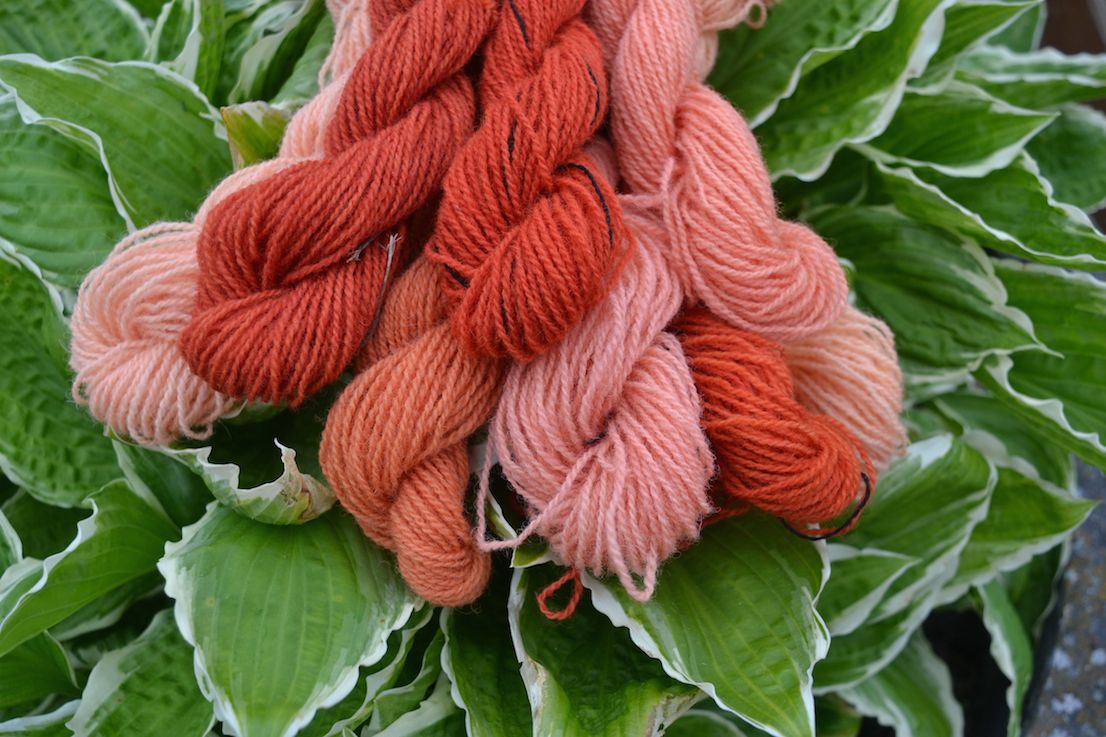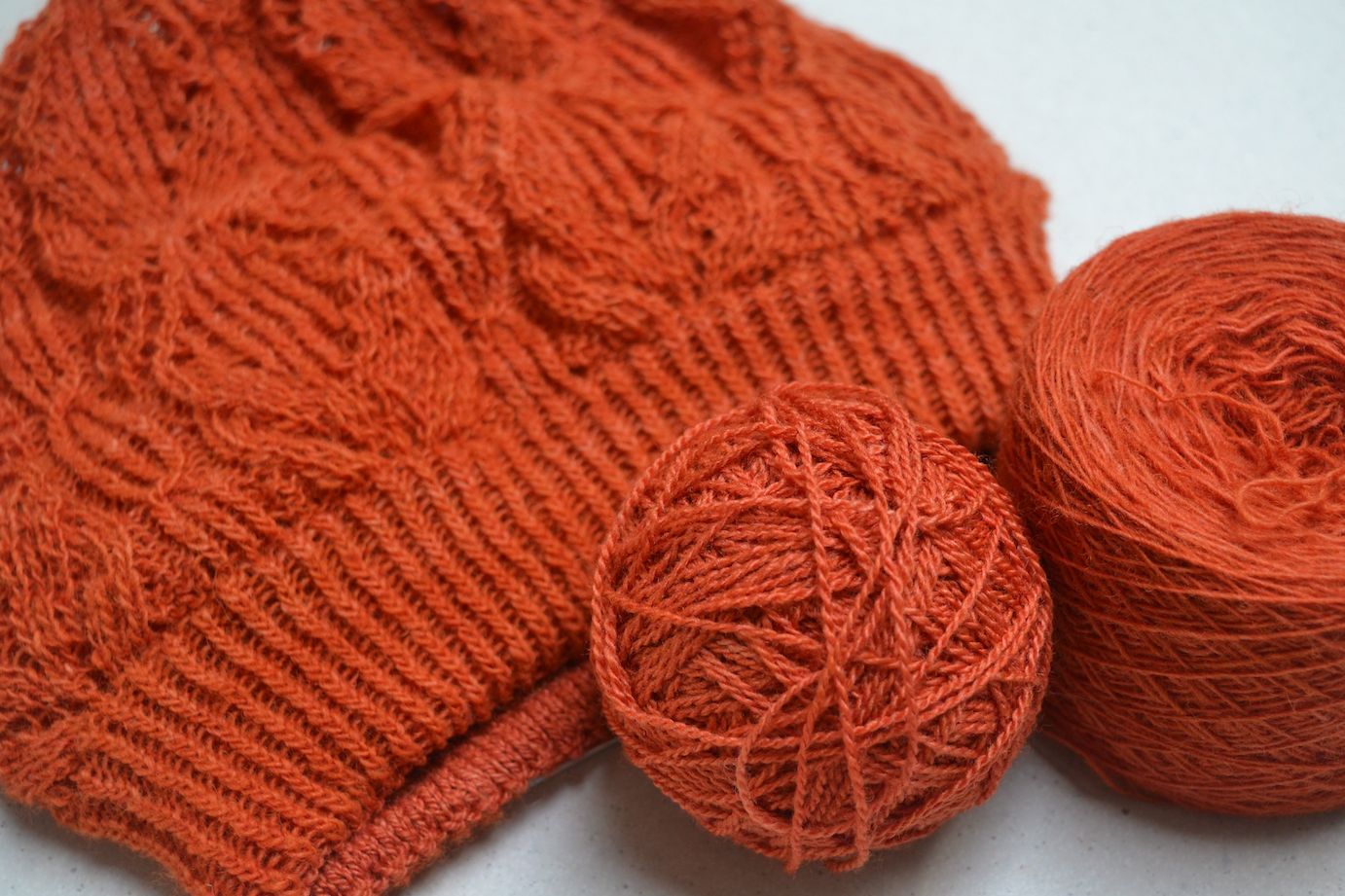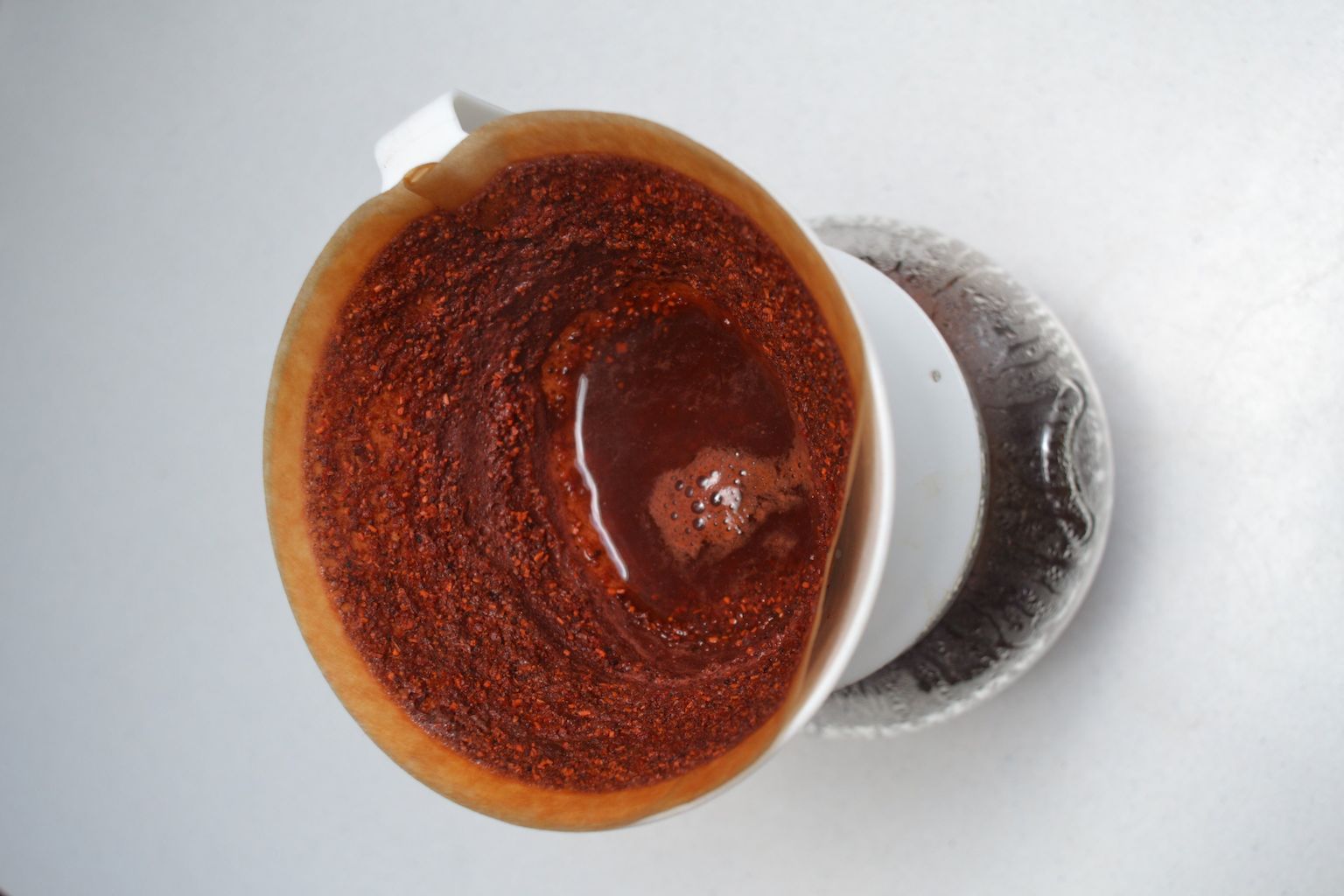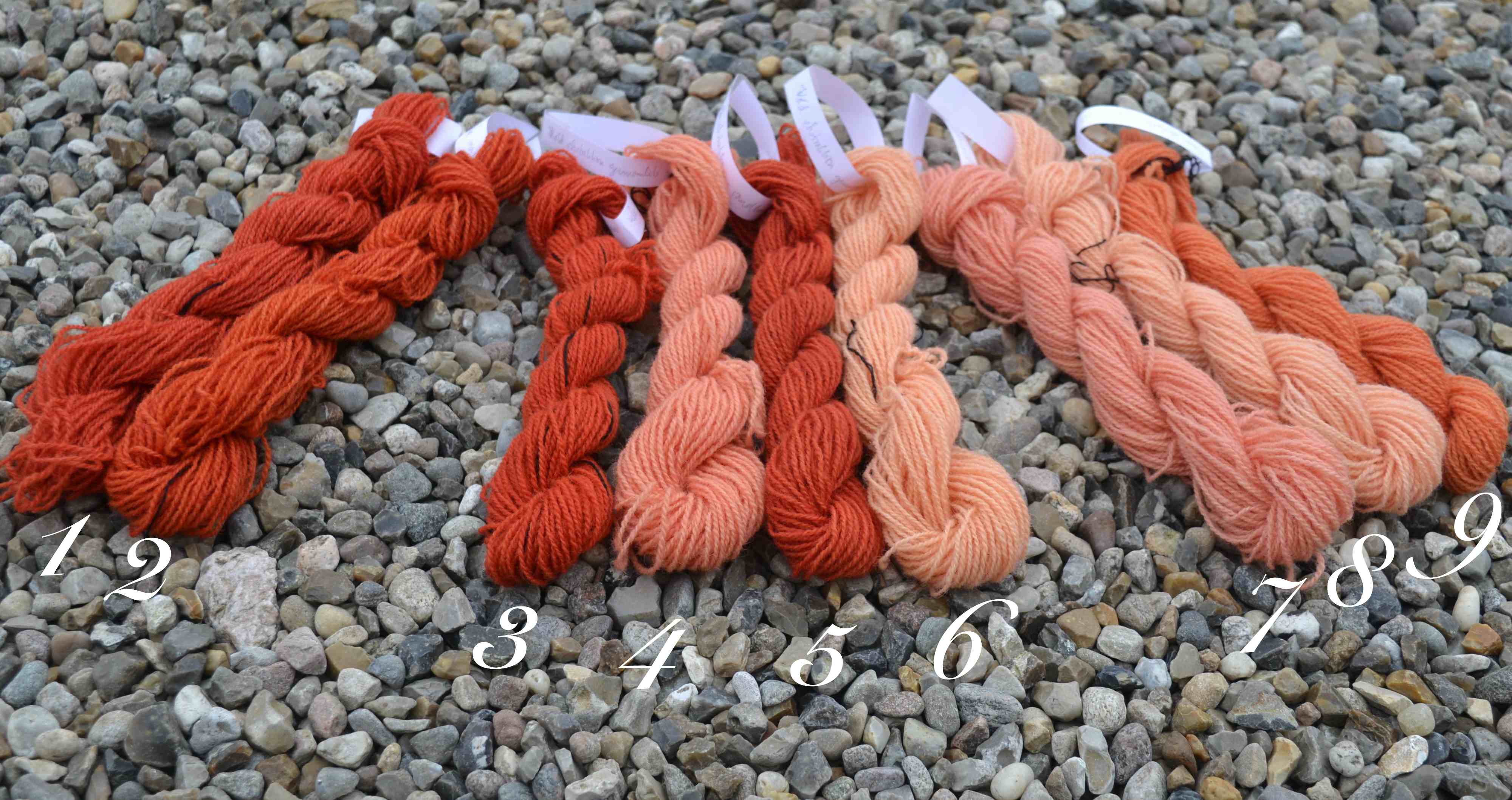Madder is one of the most ancient dyes, and one that is described in pretty much any book on natural dyeing. But every book seems to give a slightly different method for obtaining the sought-after madder red. There’s only one thing to do – experiment!

Madder was one of the first natural dyestuffs I tried just when I began learning about natural dyeing, many years ago. I followed Jenny Dean’s “Colours from Nature”, the first book I bought back then (now, of course, I have a largish library on natural dyeing).
Dean gives a dyeing method for larger pieces of madder root, not powdered root. She rinses the root in cold water, then boiling water, and then adds the water for the actual dye bath. I tried her method for my first attempts with madder, but only got a series of tan/coral shades. Sometimes slightly more pink, sometimes more towards orange.
After my first attempts, I was ready to just give up. Coral was not exactly my favorite color, and I didn’t make any further attempts with natural dyes. That was until I happened to talk to some dyers at iron age and viking markets. One of them told me, that she always got good reds with madder by using destilled water.
After that, I happened to find a copy of a classic Danish dye book from 1972, “Dyeing with Plants” by Ester Nielsen. Nielsen steeps madder for 24 hours, and mentions nothing about changing the water at any point. Also, she mentions nothing about the type of water. Over time, I arrived at a variant of Nielsen’s method, using rainwater instead of distilled water because rainwater is free. I leave the madder to steep overnight in my dyepot, add alum mordanted wool, heat slowly to 55 C, and then wrap the pot in a blanket and leave it until the next day. So, yarn and madder in the pot together, and no changing the water.
I’ve achieved many clear reds with that method, but sometimes, the color has turned out more orange than red. That’s the case with the yarn for this hat:

I do like orange, but it’s red you’re after with madder. Also, I’ve become increasingly confused the more I’ve read about madder dyeing, and I am not the only one. As mentioned, Dean uses a hot extraction (a soak in water that is discarded) whereas others, for example Ecotone Threads use a cold extraction.
Madder contains many different dye compounds. According to “Handbook of Natural Colorants” by Berchtold & Mussak, more than 35 different anthraquinones have been detected in madder (anthraquinones are the type of molecules that alizarin, the important red in madder, also belongs to). The different dye compounds have slightly different colors, so the the point of (cold or hot) extraction would be to remove some of the yellow or brownish ones.
I decided to test, whether I could get rid of my orange reds by using an extraction method. For this test, I’ve used my usual 12-gram skeins of Fenris (100% wool) mordanted with 10% alum. In all the experiments, I used 12 grams of madder powder per skein, leaving the madder in the dyepot the entire time. A few writers say that the madder should be removed from the dyepot before fiber is added, but most agree to leave it in.
According to Liles’ “The Art and Craft of Natural Dyeing”, alizarin has a very low solubility in water, and that’s why the madder should stay in the pot. As alizarin in solution is taken up by the yarn, more will be released from the madder. In all cases, I dyed the yarn by heating yarn and madder to 55 degrees C keep it there for 1 hour, and then leave the yarn in the dyebath overnight.
In my little experiment, I tested the following, both with rainwater and tap water: steeping the madder overnight and dyeing in the same water, filtering out the madder and dyeing with it in new water, and finally pouring boiling water over the madder and then dyeing with it in new water.

Results below:
1: Madder steeped overnight in rainwater, yarn dyed in the same water.
2: Madder steeped overnight in tap water, yarn dyed in the same water.
3: Madder steeped overnight in rainwater, filtered, run-off removed and yarn dyed in new rainwater.
4: Run-off from 3 (the liquid that ran through the filter).
5: Madder steeped overnight in tap water, filtered, run-off removed and yarn dyed in new tap water.
6: Run-off from 5 (the liquid that ran through the filter).
7: Poured boiling water over the madder, filtered immediately, yarn dyed in new rainwater.
8: Poured boiling water over the madder, filtered immediately, yarn dyed in new tap water.
9: Run-off from 7 (not repeated for 8, as it would be identical.

Skein 1 is dyed with just one volume of rainwater, which is my usual method. Luckily, skein 1 is one of the good reds in my test. Skein 2 is the same method, but using tap water. Skein 1 is only a slightly bit redder than skein 2, so using rainwater instead of tap doesn’t seem to have the importance that I thought. I measure pH of both baths, and they were both neutral after steeping overnight.
Skein 3 and 5 are dyed with madder that was steeped overnight, and then filtered to remove the first volume of water. If it was true that steeping and removing the water would remove yellow and brown tones, then skein 1 and 3 (both dyed in rainwater) and skein 2 and 5 (both dyed in tap water) should be different, but they are not. My conclusion is, that cold extraction does not remove yellows and browns.
That conclusion also seems to be correct when you look at skein 4 (rainwater) and 6 (tap water), which are dyed with the run-off from 3 and 5. If the extraction removed yellows and browns, then skein 4 and 6 should have those colors, but they don’t. They are tan/coral, exactly the kinds of colors I normally get from second, third and later afterbaths. So this could mean that cold extraction just removes a small fraction of the overall color present in madder.
Finally, the hot extraction. Skein 7 (rain) and 8 (tap) are dyed in new volumes of water added to the madder after the hot extraction. They are weakly colored, and the shades are very similar to those of skein 4 and 6. So most of the color is just gone after the hot extraction, and has ended up in the run-off that was used to dye skein 9.
Skein 9 has a good, saturated red-orange color, which is not that surprising. Temperature is the only factor that more or less all authors agree on. The temperature mustn’t get too high, as that brings out orange or terracotta tones, exactly what I’m seeing here. If the light fastness turns out to be good, then this is actually a very good method for dyeing orange.
It’s nice to observe that this little experiment fits with my very earliest observations with madder. Deans method gives skein 8, a pale tone that would definitely be disappointing if you are trying to dye red.
So, in summary, the conlusions of my little experiment are:
Reds obtained with rainwater and tap water are not very different, and rainwater gives a red that is only very slightly better than the red with tap water. This conclusion is for my tap water, and may be entirely different elsewhere.
Cold extraction is not efficient for removing yellows, and hot extraction removes almost all the color.
I usually keep the temperature around 55 degrees C, but I have never checked myself to see how sensitive the color is to temperature. And I haven’t even begun to look at pH and calcium. My next experiments will be on those factors.
[…] the dye. I removed the overnight water because Jenny Dean does, but I should have concluded from my madder experiments that it is not necessary to do so. The water used to soak the roots overnight simply contains a […]
[…] Earlier in the year, I had experimented to see if I could remove the yellow tones from madder by soaking the madder in hot or cold water and discarding that water before dyeing (extraction) but according to my experiments, that’s not possible. […]
Hello, and thank you for these notes. I placed madder root powder (Rubia tinctoria) in a coffee filter and poured boiling water over it, trying to recreate the method Jenny Dean uses with roots. Pouring water through a filter like this meant it did not sit in the hot water for too long, and of course the dyestuff remained in the filter. I found it did indeed take the yellow-orange edge off the dyestuff. I added the dyestuff to well water (pH 7.5 for me) and a tsp. of soda ash to raise the pH to around 9.5. (Note, I did not add calcium carbonate, as I often read to do.) Dyeing with silk in low/slow temperature, I got closer to the cooler reds and pinks I wanted; a post-modifer of soda ash got me more or less what I was looking for.
Hi Karen, thanks for your comment, I didn’t see it for a while! Interesting that this method does work for you and gives you the reds you are after! I do think the type of water is the single most important thing in the process, and is what dictates the result!
Astrid